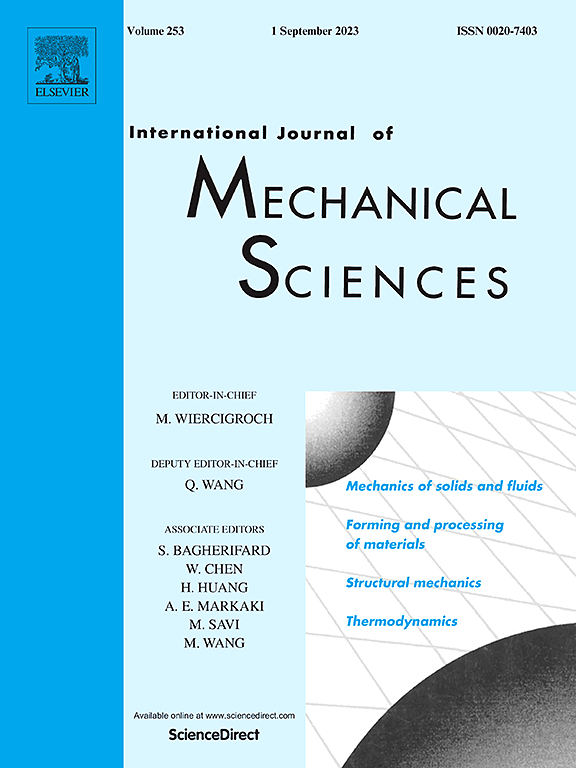三维FWP-C/C复合材料应变速率相关的层间剪切性能
IF 7.1
1区 工程技术
Q1 ENGINEERING, MECHANICAL
International Journal of Mechanical Sciences
Pub Date : 2025-06-22
DOI:10.1016/j.ijmecsci.2025.110523
引用次数: 0
摘要
三维细编织刺穿碳/碳复合材料(3D FWP-C/C)由于其优异的高温力学性能,被广泛应用于关键的航空航天热结构中。然而,这些结构不可避免地在复杂的动态环境中运行,其中3D FWP-C/C复合材料相对较弱的层间力学性能使其特别容易受到动态层间剪切(ILS)破坏。在本研究中,专门设计并优化了双剪切试样,以评估三维FWP-C/C复合材料的ILS性能。在机电通用试验机和伺服液压高速试验机上分别进行了准静态和动态实验。随后通过扫描电子显微镜(SEM)分析断口表面,揭示应变率相关的ILS破坏机制。结果表明,三维FWP-C/C复合材料的ILS失效主要是由纤维束刺穿引起的。准静态加载下,刺穿纤维束的拉伸断裂是ILS破坏的主要原因,而高应变率加载下,刺穿纤维束的剪切断裂是ILS破坏的主要原因。随着应变速率的增加,ILS强度从0.001/s时的22.738 MPa提高到1000/s时的30.859 MPa,而初始ILS模量基本保持不变。这种增强是由于在较高应变速率下基体裂纹的扩展受到抑制。三维FWP-C/C复合材料的ILS破坏过程表现为两个阶段:以基体为主的第一次损伤阶段和以纤维为主的第二次损伤阶段。随着应变速率的增加,两个损伤阶段逐渐收敛。基于这些发现,提出了一种新的应变率相关的双损伤ILS本构模型,该模型包含了两个损伤阶段,并通过实验数据进行了验证。所提出的本构模型为航空航天3D FWP-C/C复合结构在运行动态载荷条件下的动态ILS响应和渐进失效模式提供了精确的预测能力。本文章由计算机程序翻译,如有差异,请以英文原文为准。

Strain-rate-dependent interlaminar shear properties of 3D FWP-C/C composites
Three-dimensional fine weave pierced carbon/carbon (3D FWP-C/C) composites are widely employed in critical aerospace thermal structures due to their exceptional high-temperature mechanical properties. However, these structures inevitably operate in complex dynamic environments, where the relatively weak interlaminar mechanical properties of 3D FWP-C/C composites make them particularly susceptible to dynamic interlaminar shear (ILS) failure. In this study, a double-shear specimen is specifically designed and size-optimized to evaluate the ILS properties of 3D FWP-C/C composites. Quasi-static and dynamic experiments are conducted using an electromechanical universal testing machine and a servo-hydraulic high-speed testing machine, respectively. The fracture surfaces are subsequently analyzed via scanning electron microscopy (SEM) to reveal the strain-rate-dependent ILS failure mechanism. Results demonstrate that the ILS failure in 3D FWP-C/C composites is primarily governed by pierced fiber bundles. Under quasi-static loading, the ILS failure occurs due to the tensile rupture of the pierced fiber bundles, whereas at high strain rate loading, failure is primarily governed by the shear fracture of the pierced fiber bundles. With increasing strain rate, the ILS strength improves, rising from 22.738 MPa at 0.001/s to 30.859 MPa at 1000/s, while the initial ILS modulus remains nearly unchanged. This enhancement is attributed to the suppressed propagation of matrix cracks at higher strain rates. The ILS failure process of 3D FWP-C/C composites exhibits two distinct stages: the matrix-dominated first damage stage and the fiber-dominated second damage stage. Additionally, the two damage stages gradually converge with increasing strain rate. Based on these findings, a novel strain-rate-dependent dual-damage ILS constitutive model, incorporating both damage stages, is proposed and validated against experimental data. The proposed constitutive model provides precise predictive capabilities for both dynamic ILS responses and progressive failure modes in aerospace 3D FWP-C/C composite structures under operational dynamic loading conditions.
求助全文
通过发布文献求助,成功后即可免费获取论文全文。
去求助
来源期刊

International Journal of Mechanical Sciences
工程技术-工程:机械
CiteScore
12.80
自引率
17.80%
发文量
769
审稿时长
19 days
期刊介绍:
The International Journal of Mechanical Sciences (IJMS) serves as a global platform for the publication and dissemination of original research that contributes to a deeper scientific understanding of the fundamental disciplines within mechanical, civil, and material engineering.
The primary focus of IJMS is to showcase innovative and ground-breaking work that utilizes analytical and computational modeling techniques, such as Finite Element Method (FEM), Boundary Element Method (BEM), and mesh-free methods, among others. These modeling methods are applied to diverse fields including rigid-body mechanics (e.g., dynamics, vibration, stability), structural mechanics, metal forming, advanced materials (e.g., metals, composites, cellular, smart) behavior and applications, impact mechanics, strain localization, and other nonlinear effects (e.g., large deflections, plasticity, fracture).
Additionally, IJMS covers the realms of fluid mechanics (both external and internal flows), tribology, thermodynamics, and materials processing. These subjects collectively form the core of the journal's content.
In summary, IJMS provides a prestigious platform for researchers to present their original contributions, shedding light on analytical and computational modeling methods in various areas of mechanical engineering, as well as exploring the behavior and application of advanced materials, fluid mechanics, thermodynamics, and materials processing.
 求助内容:
求助内容: 应助结果提醒方式:
应助结果提醒方式:


